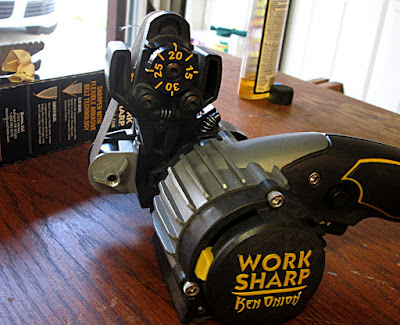I just got CRKT’s newest
Minimalist, the Cleaver.
 |
| CTKT's newest Minimalist, the Cleaver |
You might think of it as a neck axe, but I think of it as a planing edge. It weighs only 1.7 ounces. Too light to actually chop, too small to generate swinging energy, but the 2.3 inch long edge can make clean slices and the cleaver head allows you grasp the handle front end for….
Okay, it’s a bit of
a toy. But it is still a very icey toy. CRKT makes quality knives. They are, dollar for dollar the best buy in
any price range. As with the other six
Minimalist the finger grooves fit a surprisingly wide range of hands.
The blade is made from
5Cr15MOV and the elemental break down is:
Carbon - 0.45-0.50%
Chromium – 14.75%
Molybdenum – 0.68%
Vanadium – 0.10%
Manganese – 0.45%
This China’s equivalent
of the German X50CrMoV15 steel, one of the most popular kitchen knife steels in
mainstream German knives. I’ve got to
admit the sprinkle of vanadium, which forms very fine and hard carbides, ups
the quality of this steel.
It has a Rockwell
‘C’ hardness of 55 to 57. This should be relatively easy to resharpen on an ordinary stone and still hold an edge. I will not be the first to tell you, always resharpen when you think it is getting dull, not when it is dull.
 |
| Like All Minimalist it comes with a neck sheath |
CRKT calls this Minimalist “…high-carbon stainless steel cleaver (that) … safely rips through food packets or clothing thanks to the false front edge. The hole in the blade pays homage to the hanging hold on the old style kitchen cleavers.” Well, they have to say something!
It is clear that
CRKT and my definition of high carbon steel are different. 440A contains 1.1% carbon. That’s in the high carbon steel range.
It’s made in China
and as I said before it’s almost a toy, unless you need an edge. When you need an edge, well, you work with
what you have. With the sheath you can
drop the Cleaver in a pocket, duct tape inside your first aid kit, wear it
under your shirt and it will be available if you need it.
 |
| Back Side |
You can find one
for yourself under $40 at: https://www.crkt.com/minimalist-cleaver.html


